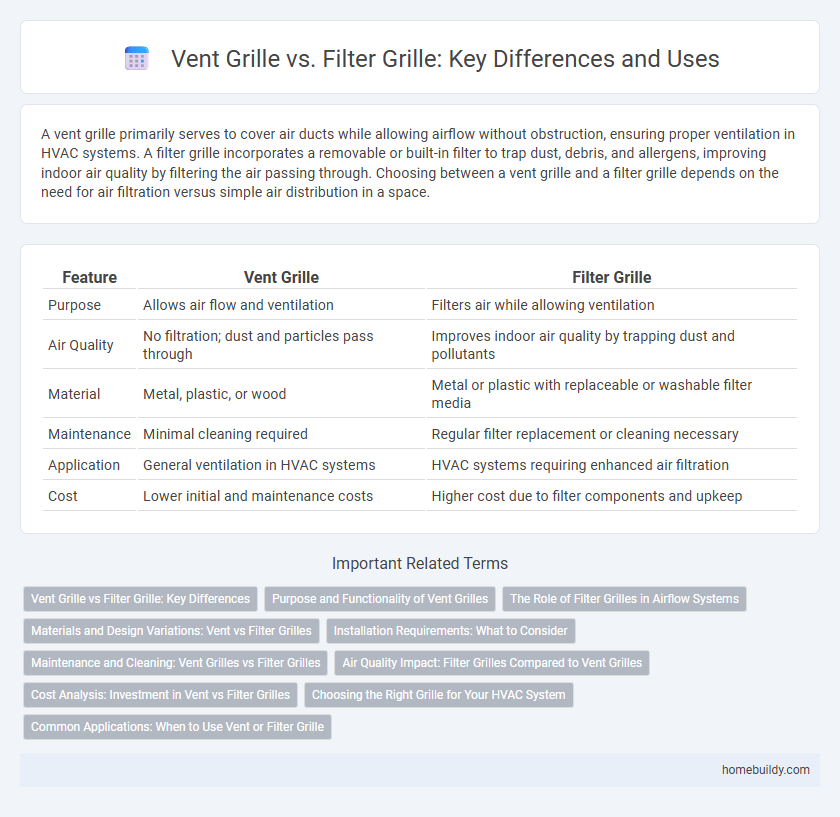A vent grille primarily serves to cover air ducts while allowing airflow without obstruction, ensuring proper ventilation in HVAC systems. A filter grille incorporates a removable or built-in filter to trap dust, debris, and allergens, improving indoor air quality by filtering the air passing through. Choosing between a vent grille and a filter grille depends on the need for air filtration versus simple air distribution in a space.
Table of Comparison
| Feature | Vent Grille | Filter Grille |
|---|---|---|
| Purpose | Allows air flow and ventilation | Filters air while allowing ventilation |
| Air Quality | No filtration; dust and particles pass through | Improves indoor air quality by trapping dust and pollutants |
| Material | Metal, plastic, or wood | Metal or plastic with replaceable or washable filter media |
| Maintenance | Minimal cleaning required | Regular filter replacement or cleaning necessary |
| Application | General ventilation in HVAC systems | HVAC systems requiring enhanced air filtration |
| Cost | Lower initial and maintenance costs | Higher cost due to filter components and upkeep |
Vent Grille vs Filter Grille: Key Differences
Vent grilles primarily facilitate air distribution and ventilation by allowing airflow through ducts, while filter grilles include integrated filters designed to trap dust, pollen, and other airborne particles, improving indoor air quality. Vent grilles are typically made from metal or plastic with open slats, focusing on airflow efficiency, whereas filter grilles combine the grille frame with replaceable or washable filters for air purification. Selection depends on the need for ventilation alone versus enhanced air filtration in HVAC systems.
Purpose and Functionality of Vent Grilles
Vent grilles primarily facilitate air circulation by covering duct openings while allowing unrestricted airflow into a room or system. Unlike filter grilles, vent grilles do not incorporate filtration media, focusing solely on protecting ducts and concealing mechanical components. Their design optimizes ventilation efficiency, ensuring proper air distribution without impeding system performance.
The Role of Filter Grilles in Airflow Systems
Filter grilles play a critical role in airflow systems by combining ventilation and filtration functions, capturing dust and pollutants while allowing adequate air circulation. Unlike traditional vent grilles, filter grilles incorporate replaceable or washable filters that improve indoor air quality and protect HVAC equipment from debris. This dual functionality enhances system efficiency and promotes healthier environments in residential and commercial applications.
Materials and Design Variations: Vent vs Filter Grilles
Vent grilles are typically constructed from durable metals like aluminum or steel, emphasizing airflow efficiency with open designs that allow unobstructed ventilation. Filter grilles incorporate similar materials but include additional mesh or perforated layers designed to hold air filters, balancing air passage with particle filtration. Design variations reflect their purposes: vent grilles prioritize maximum airflow and minimal resistance, while filter grilles focus on integrating filtration media for improved air quality control.
Installation Requirements: What to Consider
Vent grille installation requires proper alignment with duct openings and secure mounting to prevent air leaks and ensure optimal airflow. Filter grille installation demands additional space to accommodate replaceable filters and easy access for maintenance, often influencing wall or ceiling clearance. Both types must consider airflow direction, structural support, and compatibility with HVAC system specifications to maintain system efficiency.
Maintenance and Cleaning: Vent Grilles vs Filter Grilles
Vent grilles require minimal maintenance, typically involving regular dusting and occasional washing to prevent dirt buildup and ensure optimal airflow. Filter grilles incorporate replaceable or washable filters that demand periodic inspection and cleaning or replacement to maintain air quality and system efficiency. Proper maintenance of filter grilles extends HVAC lifespan by capturing contaminants, while vent grilles mainly focus on unobstructed ventilation.
Air Quality Impact: Filter Grilles Compared to Vent Grilles
Filter grilles enhance indoor air quality by incorporating replaceable or washable filters that trap dust, pollen, and other airborne particles, unlike standard vent grilles that primarily serve as airflow channels without filtration. The inclusion of filters in filter grilles reduces allergens and improves overall ventilation effectiveness, contributing to a healthier environment. Vent grilles offer minimal filtration benefits and are mainly designed for aesthetic coverage and air distribution.
Cost Analysis: Investment in Vent vs Filter Grilles
Vent grilles generally require lower initial investment compared to filter grilles due to simpler materials and design, making them cost-effective for basic airflow needs. Filter grilles involve higher upfront costs driven by integrated filtration media essential for improving indoor air quality and protecting HVAC components. Long-term maintenance expenses for filter grilles can be offset by enhanced system efficiency and reduced contamination-related repairs, influencing overall lifecycle cost.
Choosing the Right Grille for Your HVAC System
Vent grilles and filter grilles serve distinct functions in HVAC systems, with vent grilles primarily facilitating airflow while filter grilles incorporate filtration elements to improve indoor air quality. Choosing the right grille depends on system requirements, air filtration needs, and the desired balance between airflow efficiency and particulate removal. Proper selection ensures optimized system performance, energy efficiency, and healthier indoor environments by matching grille type to HVAC design and maintenance capacity.
Common Applications: When to Use Vent or Filter Grille
Vent grilles are typically used in HVAC systems for air distribution and return, allowing free airflow without restricting ventilation. Filter grilles combine airflow with filtration, making them ideal for environments requiring dust, pollen, or particle control, such as hospitals or cleanrooms. Choosing between vent and filter grilles depends on the need for air quality management versus basic ventilation efficiency.
vent grille vs filter grille Infographic

 homebuildy.com
homebuildy.com